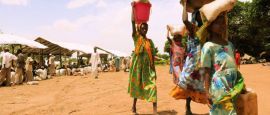See some rare examples of beautifully constructed wooden houses in the friendly town of Zinga on the Ubangi River, one of the Congo’s largest tributaries. The most atmospheric way of reaching the town is by motorboat or traditional canoe from Bangui, which lies some 100km (60 miles) north of Zinga.
Central African Republic things to see and do
Shaded by tropical greenery, Bangui’s city centre is a fine place to while awaya day or two. Star attractions include the tomb of the emperor-president Jean-Bédel Bokassa, which lies in the Berengo palace grounds, and a colourful central market renowned for its malachite necklaces. The Grande Corniche leads to the banks of the River Ubangi and provides a picturesque view of the fishermen's round huts and traditional canoes.
In the dry season, take a 4x4 and spot wildlife in the Central African Republic's national parks. The three most important are Manovo-Gounda St Floris, known for its high concentration of hippos, Bamingui-Bangoran in the north and Dzanga-Sangha in the southwest. The game population of the parks is impressive.
At 250m (820ft) wide and 50m (165ft) high, the plunging Mbali River waterfalls near the charming village of Boali are a wonderful spectacle. Those wishing to linger and enjoy the views should grab a seat at the riverside restaurant, before paying a visit to the nearby hydroelectric power plant, which harnesses the energy of the cascading water.
Basketball is the country's most popular sport and a good way to forge connections with the people of the Central African Republic. Almost every town has some sort of space for playing, while league teams meet regularly to fight for the title. International games are often screened in bars and cinemas.
A great place to pick up a souvenir in a relaxed atmosphere, the capital’s artisan market displays a range of traditional products from across the country. Handicrafts for sale include woven products, pottery, musical instruments, such as the xylophone-like balafon, and other hardwood carvings from the country’s forested tropical belt.
Around the town of Bouar, in the east of the country, 70 groups of upright megaliths called tajunu mark the locations of ancient burial mounds. Standing up to 5m (16ft) high, they are thought to date from Neolithic times, making them roughly the same age as England’s Stonehenge.
The Dzanga-Sangha Reserve near Bayanga provides the opportunity to get up close and personal to several groups of habituated lowland gorillas while taking advantage of the good quality accommodation on offer. The platforms overlooking Dzanga and Sangha bais almost guarantee sights of shy forest elephant in search of a mud-bath.
See indigenous forest tribes, including Pygmy people, living in encampments of small, low huts made of lianas and roofed with leaves in the Lobaye Region, 100km (60 miles) from the capital. The region is also known for producing coffee and visitors can visit plantations on the fringe of the forest, outside urban centres such as M’Baïki.
Close to Kembé, a traditional village with mud-brick huts bearing thatched roofs, the Kotto River is churned white as it cascades over a spectacular V-shaped waterfall. Villagers use the river for washing and bathing, while children play in its strong currents most days.
Do you have any Feedback about this page?
© 2025 Columbus Travel Media Ltd. All rights reserved. No part of this site may be reproduced without our written permission, click here for information on Columbus Content Solutions.








 You know where
You know where